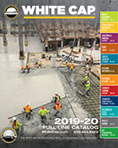Be Seen and Be Safe!
With no shortage of potential hazards on a construction site, worker safety is job one. One of the best ways to protect workers, especially those who work on or near equipment and moving vehicles, is by outfitting them in High-Visibility Safety Apparel (HVSA), aka “Hi Viz” apparel. HVSA is designed to protect workers exposed to potential on-the-job hazards by providing enhanced visibility—and if you wear them or work around them, you know how truly visible they can be.
Types and Classes of Hi Viz
There are three types and four classes of high visibility safety apparel that comply with American National Standard (ANSI/ISEA) 107. Where you unpack your tools every day dictates the type and class you’ll need for high visibility and maximum safety. For construction workers of all trades, Type O and Type R garments are for you.
- Type O (off-road) – For occupational workers who are not exposed to highway traffic, but still work in an environment with moving vehicles and equipment.
- Type R (roadway) – For occupational workers who are exposed to roadway traffic and struck-by hazards, and who work in an environment with moving vehicles and equipment.
- Type P (public safety) – For public safety workers such as police, fire and EMS, who are exposed to struck-by hazards in both roadway and off-road work environments.
The types further break down into performance classes. The performance classes indicate the placement and amount of background material and retroreflective material on the gear.
- Class 1 – provides the minimum amount of reflection and is required in less complex work environments.
- Class 2 – provides a higher amount of reflection to define the wearer more effectively.
- Class 3 – provides greater visibility with a greater mix of complex backgrounds of retroreflective material through a full range of body movement.
- Class E – represents garments with legs, like pants, coveralls, raingear, and includes gaiters.
Retroreflective material are the bands of reflective trim that encircle the garment in various places and reflect a high proportion of light. These bands provide more than your average reflection; they are designed to return light in the direction of the light source and are extremely bright and visible.
Class E
The Class E garments include those with legs: coveralls, pants, raingear and gaiters. Class E garments worn alone do not fully meet HVSA safety requirements. However, when worn with a Class 2 or 3 garment such as a vest, shirt or jacket, the combination bumps the protection up to Class 3 and fully illuminates a worker.

Get in Gear
High visibility safety apparel comes in all forms, from the minimal coverage of vests and shirts, to the fuller coverage of jackets, pants, coveralls and raingear. Each garment has specs for the background and retroreflective material. The right gear for each worker depends upon the job and its location.
A worker in a low impact area can simply put on a Class 2 vest and have adequate protection. Someone working in an area in and around moving vehicles and equipment, or where there is poor visibility, may want to wear a full Hi Viz combo of pants with a shirt or jacket.
It’s all about the Retroreflective Material
The reflective bands—officially called retroreflective material—are what make the apparel highly visible and safe. HVSA must meet minimum requirements for the width and placement of the bands to be compliant. There are many variations in retroreflective material size and placement depending upon the performance class—so our focus here will be on construction-related occupations that adhere to Class 2 and 3 apparel.
HVSA must provide full visibility for workers; this usually means the retroreflective material encircles some part of the garment (around torsos, arms, legs, etc.). For vests, there are specific requirements regarding where on the front and back of the shoulders the retroreflective material needs to be located.
The performance class dictates the width and placement of the retroreflective bands. For Class 2, Class 3, and Class E gear, look for retroreflective bands that:
- Include a specific width
- Provide 360 degree visibility
- Maintain appropriate separation of vertical and horizontal bands
- Adhere to appropriate placement
Class 3 garments are required to have at least one retroreflective band circling each sleeve.

Be Seen and Be Safe!
The purpose of wearing this gear is to be seen and be safe on the jobsite. And it’s not just about adding reflective bands to material, the background material of the HVSA apparel is also highly visible.
The fabric that HVSA garments are made from incorporates special pigments that makes them appear brighter than regular color garments. The ANSI/ISEA 107 standard has specs for color, brightness, and fabric strength. High visibility safety apparel comes in fluorescent yellow-green, orange and red; there are minimum performance characteristics for the colors. It is this combination of special fluorescent fabric and retroreflective band material that gives HVSA extreme visibility in daytime as well as nighttime settings.
Water resistance is an additional requirement for certain high visibility safety. For occupational environments exposed to weather and rainfall, the standard requires that garments be tested as water repellent, water resistant, and water proof.
A Note on Size
Since ANSI/ISEA has specific requirements about the distance between the retroreflective bands, smaller size garments may not have the space to conform. However, workers of smaller stature wearing oversized apparel is not safe. Therefore, there is some allowance for a reduced area of visible background material for the smallest size of HVSA Type R garments. Be sure your high visibility safety apparel fits properly no matter your size.

A Little Background
HVSA protections for construction workers originally came from the protection of roadway workers. It was the U.S. Department of Transportation’s Federal Highway Administration (FHWA) that implemented ANSI/ISEA 107 in 1999. The standard regulates the design and performance of safety apparel to signal the presence of workers on or near roadways. Since then, the High-Visibility Safety Apparel and Headwear Standard has been revised and improved several times to where it now covers construction workers who work near equipment and moving vehicles.
Federal, state and local authorities, and many private industry organizations related to transportation, recognize and comply with these safety standards. Today, it is important to look for high visibility safety apparel that meets the most recent revision the standard: ANSI/ISEA 107-2015
Check the Label
High visibility safety apparel is meant to draw attention to the workers wearing it and to prevent injury or fatality. Check the label to ensure your HVSA gear is ANSI/ISEA compliant. The label is required to show the type (O, R, or P) and class (1, 2, 3 or E). It must include manufacture name, item number and style of product. One of the first things label should list is the current standard, with the most recent year; ANSI/ISEA 107-2015. The label will also list whether or not the garment is specifically flame resistant. Depending upon your trade, this may or may not be a factor in selecting safety apparel.
Today’s Hi Viz apparel makes it easier than ever to protect all types of workers from jobsite accidents, equipment, and moving vehicles. Outfitting workers in high visibility safety apparel that meets standard and fits properly, adds an important layer of protection from potential hazards.




